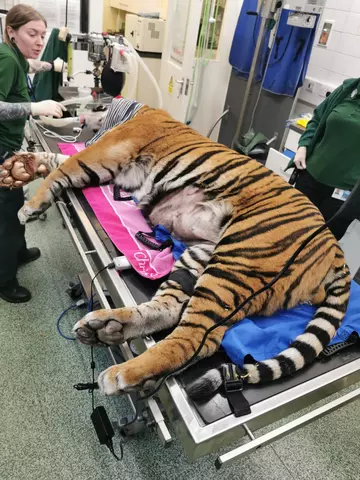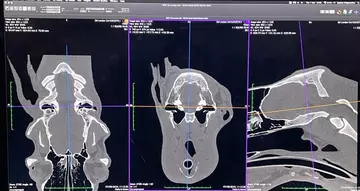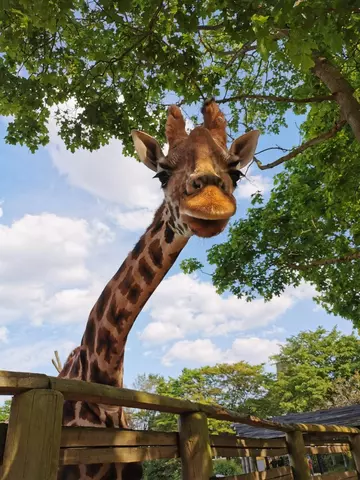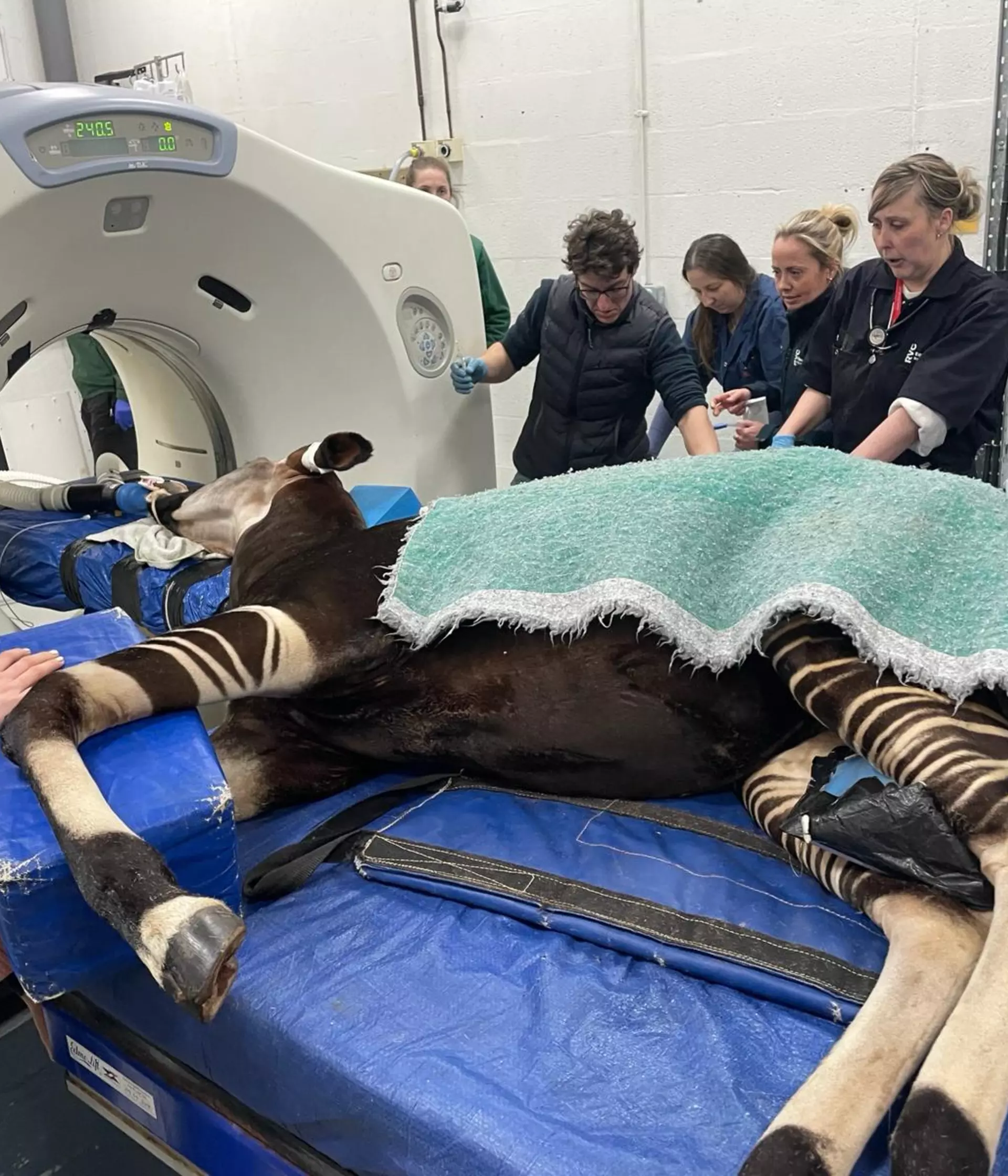
The Zoos' Remarkable Vets
Responsible for looking after the more than 24,000 animals at London and Whipsnade Zoos, our vets ensure each and every animal receives the finest health care – from tiny invertebrates to mighty predators.
Recently our vets at London Zoo have had their incredible skills put to the test, from investigating the cause of an earache in an okapi to performing live saving surgery on a critically endangered big cat. Not every veterinary case ends the way we would hope, but our expert vets approach each one with the same compassion and care. Read on to hear about the remarkable work of our animal care teams, from ZSL’s Senior Veterinary Officer Taina Strike and Curator of Mammals Sarah Forsyth.
Life-saving big cat surgery

Sarah: At the end of February, our big cat keepers noticed that Asim, the adult male Sumatran tiger at London Zoo, was off his food, he was lethargic and vomiting – all really concerning signs that our usually boisterous big cat was seriously ill.
The big cat keepers alerted us and between the vets and zookeepers, we kept a close watch on him, and when after a day or so he showed no signs of feeling better, we knew we had to take a closer look.
As you can imagine, moving a big cat is no simple feat, so we carry out investigative procedures in their dens. Asim was given a general anaesthetic at Tiger Territory, and we got to work carrying out a thorough health check.
Taina: Our veterinary officer carried out an x-ray of Asim’s abdomen, which revealed there was something there that shouldn’t be. We knew we had to get Asim up to the veterinary hospital for further investigation, and hopefully treatment. I had been working at our other site, Whipsnade Zoo, all morning, so rushed back to London to help with Asim’s surgery.
We had to get Asim to the vet hospital quickly, carefully and safely – we had to close part of the zoo so we could transport him from Tiger Territory to the hospital and get him into the operating theatre.
Asim was swiftly operated on, and a blockage – caused by a piece of bone – was found in his intestines. Thankfully we were able to remove all of the bone during the procedure, and Asim was returned to Tiger Territory to recover from his surgery.
Intestinal surgery is a serious and very delicate procedure, and recovery can be slow. We’re still keeping a close eye on Asim to make sure he’s recovering as he should be.
Thanks to the quick responses of our big cat team, who immediately recognised the severity of Asim’s symptoms, we were able to intervene quickly and save his life – something we are all so grateful for.
Okapi with an earache

Taina: Most of our veterinary cases are not emergencies – thankfully – we do lots of routine check-ups, provide annual vaccinations for animals, and we even teach trainee vets at our hospital.
Thanks to the health benefits of getting a meticulously planned and nutritious diet, enriching habitats and world-class veterinary care, we have many animals living longer lives than they would in wild, so we also spend time treating them for ailments associated with old age, like arthritis or dental issues. For all of these, we rely on insights from the animals’ dedicated keepers to help us plan our care.
But sometimes what’s causing an animal discomfort or to behave differently isn’t immediately obvious.
Sarah: Oni, our female okapi has been under the care of our vets for what appears to be a recurrent earache. Oni’s keepers work closely with her all the time – she’s trained to follow a target for example, which means that if they need to move her from one part of her habitat to another, they can do so easily. Thanks to their close relationship with Oni, they were really quick to notice her doing something new – a little head flick, like something was irritating her.
Taina: Oni was examined, her ears were checked and cleaned, but nothing was found. Despite this, Oni continued to appear as if she had an irritated ear, so a follow up procedure was planned to look a little deeper but still nothing could be seen. So we called on the RVC – the Royal Veterinary College - who have equipment designed for horses at their specialist equine surgery unit, which would enable us to investigate further.
Thanks to her training and trust in her keepers, Oni didn’t have to be sedated for her journey to Potters Bar - she walked happily into the transport trailer behind her faithful keeper and was taken to the RVC hospital.
Once at the RVC, Oni was given a CT scan – effectively a 3D x-ray of her skull so we could see everything going on. We could quickly confirm that it definitely wasn’t an ear infection and there was nothing wrong with Oni’s inner or middle ear, a huge relief.
We now know what it is we’re dealing with – a likely allergic reaction – and we have a treatment plan. Being able to use this technology was a gamechanger for us; and we’re always delighted when we’re able to go that extra step for our animals.
Maggie the giraffe

Taina: Sometimes however, despite the most herculean of efforts, we just don’t get the result we want. This week, we sadly said goodbye to Maggie the giraffe.
Maggie the giraffe has been experiencing lameness and limb discomfort for some time, due to chronic osteoarthritis. Maggie’s keepers made sure her environment accommodated her every need, and we were treating Maggie to address both the cause and symptoms. She was given various medications to ease her pain, which had allowed her to live her life fully and comfortably alongside her sister Molly and Nuru.
In recent months, Maggie’s condition worsened – her pain medication, which could not be increased, was no longer providing her the relief it once did, and our formerly inquisitive and confident giraffe was noticeably slower and subdued. Maggie’s condition was no longer treatable.
One of the hardest parts of our job is accepting when we’ve done all we can, and the kindest decision we can make for that animal is to end its suffering. We didn’t want to see Maggie in pain any longer.
Sarah: We know that so many of you, like us, will be saddened by the loss of Maggie. She had a huge impact on our millions of visitors, especially during the covid-enforced lockdowns of 2020 when people who were out for their daily exercise stopped to pay her a visit from the zoo’s perimeter. But she will continue to have an impact on conservation and animal care.
Every animal who dies at London Zoo is given a post-mortem examination, which not only helps us to identify or confirm a cause of death but provides an unparalleled opportunity to build knowledge of endangered species – many of which we still know very little about.
We’ll share our results and findings of Maggie’s examination with veterinarians and conservationists around the world, helping to ensure we can better protect and conserve giraffes in the future. Thanks to our work with our partners at Nature’s SAFE and EAZA (European Association of Zoos and Aquaria), some of Maggie’s tissue will also be cryopreserved. This will allow for the future regeneration of live reproductive cells and cell lines, which can help to save endangered species. It’s a legacy we’re proud to be able to give her.
How your membership helps
Your membership fee helps us as a charity to fund the incredible work of our teams here at the Zoos and our dedicated conservation teams around the world, to protect the precious animals in our care and the incredible species that need our help in the wild. Every pound makes a difference, and we are very grateful for your support.
